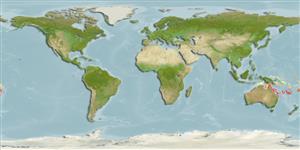>
Pleuronectiformes (Flatfishes) >
Bothidae (Lefteye flounders)
Etymology: Engyprosopon: Greek, eggys = nearly + Greek,prosopon = a face (Ref. 45335).
Environment: milieu / climate zone / profondeur / distribution range
Écologie
marin démersal; profondeur 67 - 88 m (Ref. 9824). Tropical
Western Central Pacific: Chesterfield and Bellona Plateaus and Fairway Ridge, Coral Sea.
Taille / Poids / Âge
Maturité: Lm ? range ? - ? cm
Max length : 8.6 cm SL mâle / non sexé; (Ref. 9824)
Pelvic fin on eyed short (3.1 to 3.2 times in head length in both sexes) and with some black spots. Pectoral-fin length on eyed side about twice as long as head in males, subequal to or more than head length in females. Interorbital region uniformly coloured (Ref 42535).
Body shape (shape guide): short and / or deep.
Life cycle and mating behavior
Maturité | Reproduction | Frai | Œufs | Fécondité | Larves
Hensley, D.A. and K. Amaoka, 2001. Bothidae. Lefteye flounders. p. 3799-3841. In K.E. Carpenter and V. Niem (eds.) FAO species identification guide for fishery purposes. The living marine resources of the Western Central Pacific. Vol. 6. Bony fishes part 4 (Labridae to Latimeriidae), estuarine crocodiles. FAO, Rome. (Ref. 9824)
Statut dans la liste rouge de l'IUCN (Ref. 130435: Version 2025-1)
Menace pour l'homme
Harmless
Utilisations par l'homme
Outils
Articles particuliers
Télécharger en XML
Sources Internet
Estimates based on models
Preferred temperature (Réf.
123201): 21.3 - 24.9, mean 24.2 °C (based on 3 cells).
Phylogenetic diversity index (Réf.
82804): PD
50 = 0.5000 [Uniqueness, from 0.5 = low to 2.0 = high].
Bayesian length-weight: a=0.00912 (0.00408 - 0.02036), b=3.04 (2.85 - 3.23), in cm total length, based on LWR estimates for this (Sub)family-body shape (Ref.
93245).
Niveau trophique (Réf.
69278): 3.5 ±0.4 se; based on size and trophs of closest relatives
Résilience (Réf.
120179): Milieu, temps minimum de doublement de population : 1,4 à 4,4 années (Preliminary K or Fecundity.).
Fishing Vulnerability (Ref.
59153): Low vulnerability (10 of 100).
🛈
